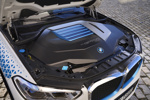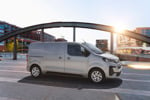Combining a traditional petrol engine with an electric motor for supplemental power, hybrids promised emission-free motoring around town, and the traditional range and comfort of the internal combustion engine.
They’ve been highly successful, with many major manufacturers now producing – or about to produce – hybrids of their own.
But not all are playing catch-up.
The technology has moved on in the eight years since the Insight first hit the road, and a new type of hybrid could soon be available.
At various motor shows across the world this year, many manufacturers have shown hybrid concept cars with a difference – known as plug-in hybrids.
These concepts, some of which have entered limited testing programmes, allow users to plug their hybrid cars into the mains electricity supply to recharge the battery pack.
The key difference is in terms of the way the battery is charged – regular hybrids such as the Prius and Honda Civic IMA use power from the engine.
Plug-ins will supplement this link, allowing for a larger battery pack which will give more range for drivers on battery-only power.
Currently, the Prius and Civic can operate only for very short distances solely using battery power, but a plug-in version could extend that by up to 40 miles.
This would make a lot of sense in the UK, especially as many hybrid vehicles are used in and around London where they are exempt from the congestion charge and complete mainly shorter stop-start journeys.
General Motors is also muscling in on the party and has announced that it will have a plug-in hybrid on the road by 2010.
Toyota, long at the forefront of hybrids, is not being left behind – it is testing a fleet of plug-in Priuses with energy firm EDF in France.
Volvo unveiled its C30-based ReCharge Concept at the Frankfurt Motor Show and Nissan has announced it is researching plug-in hybrid technology at its new research and development facility in Japan.
And Honda is taking things another step further.
Not only will it have a road-going fuel cell car on sale next year in the shape of the FCX Clarity, but it is also ramping up the development of its Home Energy Station – a device which not only provides power for a house but also allows a fuel cell car to be plugged in and recharged.
It has also given the green light to a further two hybrid models – a production version of the CR-Z coupe and a supermini hybrid.
One of the first UK firms to realise the potential of plug-in hybrid technology was not a car manufacturer, but a battery supplier – Amberjac.
It has already produced 10 plug-in hybrids, based on the Toyota Prius, for customers and plans to build 200 in 2008.
Managing director Simon Sheldon says he hoped to capitalise on the interest from major manufacturers and work with them in developing new batteries.
“The concept has been around for a long time,” he says.
“It was first thought of almost 20 years ago, but what has enabled it to move forward is battery technology.
“The small, practical electric vehicle is still some way away because it’s not economically viable. A plug-in hybrid is very much a halfway house. It’s a long-term interim solution that people are looking for.”
Mr Sheldon explains that as well as the benefit of extra range on battery power, plug-in hybrids also allow electrical power to come from a more sustainable source, as long as the customer is using a renewable electricity supplier.
“In traditional hybrids, the battery is charged by the petrol engine,” he says.
“We are using grid electricity, and averaging more than 100mpg.
“We really want to be working directly with the manufacturers, but we have started off with retro-fit kits and will continue with those at the moment.”
Mr Sheldon firmly believes that plug-in hybrids can fill a gap between current green solutions and the holy grail that is hydrogen fuel cell technology.
“This technology is proven over 600,000 miles of testing,” he says. “Hydrogen has been 20 years away for the past 20 years and still is. Some say it will never make it commercially.
“Biofuels is subject to the food or fuel question – we can’t do both.”
If it wasn’t a viable way forward, he adds, he wouldn’t be doing it.
“We don’t want to get into anything that we can’t deliver as a commercial product,” he says.















Login to comment
Comments
No comments have been made yet.